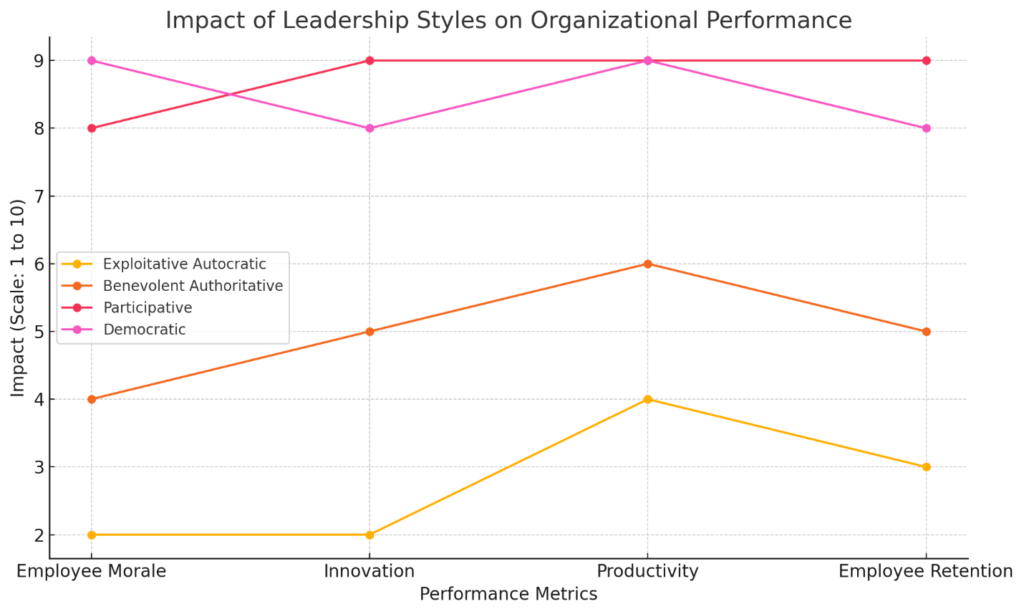
Introduction
The Role of Leadership Styles in Enhancing Organizational Financial Performance: Management is centre to the culture, performance and output of any organisation as they provide direction. In the contemporary evolving global context, organizations depend on performances of their leaders by mobilizing employees, reasoning appropriately and consequently charting the right course for their organisations. This type of assessment examines leadership and its impact on organizational performance in skills, traits, and style acquired by leaders to meet organizational objectives in both the short term and the long term.
The scenario focuses on a small to medium global organisation with the team of ten people engaging with customers on a daily basis and selling organisation’s products. It is consequently important for a team leader to show leadership skills of employee motivation, coordination and directing to accomplish individual and organizational goals. This self-checking quiz assesses the competencies need at various levels and the impact of leadership styles on organizational performance by employing different leadership theories, models, and principles.
Additionally, it also explores issues to do with goals and management behavior, and which behavior types are suitable for various types of organizations, sectors, activities, and circumstances. Last, approaches used in creating leadership are discussed to ensure that leaders are well prepared to address different difficulties and environments. By way of evaluation and analysis, it becomes evident that strategic leadership is central to sustainable organisational success.
1. leadership styles

1.1: Identify Different Skills and Characteristics of Successful Leaders
Successful leaders possess a variety of skills and characteristics that enable them to drive organizational success effectively.
Effective communication: One of the most crucial skills is effective communication, which allows leaders to convey their vision, provide feedback, and foster collaboration among team members. According to Emeritus (2022), strong communication helps clarify expectations, reduce misunderstandings, and create a cohesive team environment. Furthermore, Forbes (2017) highlights that leaders must balance speaking and active listening to inspire confidence and trust among their followershttps://finanacialconsultancy.com/.
Emotional intelligence: Another key trait is emotional intelligence, which comprises self-awareness, empathy, and interpersonal skills. Leaders with high emotional intelligence can better understand and manage their emotions while fostering positive relationships with employees (Goleman, 1995). This trait is vital in creating an inclusive and supportive workplace culture, enhancing employee satisfaction and retention.
Strategic thinking: This is another indispensable skill for leaders. Strategic thinkers anticipate challenges, identify opportunities, and align organizational resources to achieve long-term goals (Hitt et al., 2020). This proactive approach minimizes risks and ensures the organization remains competitive in dynamic markets.
Risk-takers: Additionally, successful leaders are risk-takers, as innovation often stems from venturing into uncharted territory. Sigma Assessment Systems (2020) suggests that employees perceive leaders who take calculated risks as more dynamic and inspiring, even when outcomes are uncertain. This willingness to embrace uncertainty fosters a culture of innovation and adaptability.
Motivation and vision: Lastly, motivation and vision are integral characteristics of successful leaders. Leaders inspire their teams by articulating a compelling vision and demonstrating optimism about the future (Forbes, 2017a). This approach not only drives employee engagement but also ensures alignment with organizational goals.
The interplay of these traits significantly impacts organizational performance. For example, effective communicators can resolve conflicts swiftly, while emotionally intelligent leaders create an environment conducive to collaboration and productivity. Strategic thinkers ensure sustainability, and risk-takers drive innovation, all of which are essential for achieving short- and long-term objectives.
To provide further detail on each of the mentioned traits, the following table showcases the link between a successful leader’s traits and the effect it has on employees or the organisation, based on the latest research and literature:
| Trait | Effect on the Employee/Organization |
| Motivating | Goals and tasks are more likely to be accomplished when employees are motivated. Leaders who understand intrinsic and extrinsic motivators enhance team performance (Deci & Ryan, 2020). Motivation fosters engagement, loyalty, and productivity within teams, driving organisational success (Gagné et al., 2022). |
| Effective Communicator | Communication is a critical skill for leaders to articulate visions, goals, and expectations clearly (Baldoni, 2021). Strong communication fosters trust, aligns team efforts, and increases productivity (Emeritus, 2022). Effective leaders listen actively and adapt their messaging to diverse audiences, enabling cohesive teamwork (Ruben & Gigliotti, 2021). |
| Risk-Taker | Risk-taking drives innovation and creativity within an organisation. Leaders who take calculated risks inspire teams to explore new opportunities and embrace change (Dyer et al., 2021). Failure is viewed as a learning opportunity, encouraging a growth mindset (Sigma Assessment Systems, 2020). Leaders who manage risks effectively build resilience in volatile markets (Kotler et al., 2022). |
| Plans for the Future | Strategic foresight is essential for anticipating challenges and leveraging opportunities (Voros, 2020). Leaders who focus on long-term goals guide their organisations toward sustainable growth (Johnson et al., 2021). Effective planning reduces uncertainty and enhances preparedness for potential crises (Grant, 2022). |
1.2: Assess How Different Leadership Styles Can Influence an Organization
Leadership styles significantly shape an organization’s culture, employee motivation, and overall performance. Rensis Likert’s leadership framework identifies four distinct styles—exploitative autocratic, benevolent authoritative, participative, and democratic—each with unique impacts on organizational dynamics (Likert, 1961).

Exploitative autocratic: An exploitative autocratic leadership style, characterized by a lack of trust in subordinates, strict control, and minimal delegation, often results in a hierarchical and rigid workplace environment. This style suppresses creativity and may lead to high employee turnover due to dissatisfaction. For instance, a leader who micromanages tasks without considering employee input might hinder innovation and demoralize staff (Bass & Avolio, 1994).
Benevolent authoritative: In contrast, a benevolent authoritative leader exhibits limited trust in employees but involves them occasionally in problem-solving. While this approach fosters slightly better morale than exploitative autocracy, it still limits employee autonomy. Employees may feel undervalued, which can stifle long-term motivation and innovation (Online Business School, 2022).
Participative leadership: on the other hand, emphasizes collaboration and shared decision-making. Leaders who adopt this style value employee input and foster a sense of ownership in organizational success. Research by Yukl (2013) indicates that participative leadership enhances job satisfaction, boosts creativity, and improves organizational performance. For example, companies like Google have successfully implemented participative leadership to drive innovation through employee empowerment.
Democratic leadership: Likewise, democratic leadership involves employees in decision making, and makes everyone feel welcomed to present his or her idea. This approach entrenches mutual trust, openness, and accountability as outcomes toward developing the most effective organizational culture. Bass (1985) further noted that democratic leadership enhances positive organizational performance through adoption of employee participation and exercising of initiative. For example, workers in organizations whose leadership systems are democratic prefer to work harder and stay with the organization than those under autocratic leadership systems because of the inclusive systems in the workplace.
The mere selection of the leadership style also affects how organisations deal with organisational issues. For example, autocratic patterns may be appropriate in situations when fast decisions are necessary, and participative or democratic ones – in context of permanent cooperation and firing up ideas.
Thus, the findings of this paper reveal that leadership behaviour has the most impact on culture, engagement, and productivity of an organisation. Therefore, leadership practice should be context sensitive, focusing on matching leadership behaviour with required leadership practices in view of goals and objectives of the organization.
2. leadership theories

2.1 Appreciate and Comment on Different Leadership Theories, Models, and Principles
The Role of Leadership Styles in Enhancing Organizational Financial Performance: Leadership theories, models and principles are important lenses through which one must analyse how leaders can better direct people towards the achievement of goals.
Kurt Lewin’s Leadership Styles: The most well-known is Kurt Lewin’s Leadership Styles model, which divides leadership into three types; autocratic, democratic, and laissez-faire (MindTools, n.d.). The democratic style is appropriate for a situation when employees require constant motivation and the ability to participate in decision making. On the other hand, autocratic leadership is appropriate in a situation where the need for decision making is fast and special leadership style of laissez-faire is suitable for a setting with a highly motivated and a well trained group of employees.
Blake-Mouton Managerial Grid: Another worthwhile model is the Blake-Mouton Managerial Grid that measures the concern for people against the concern for production. Managers, who manage to balance these dimensions, produce high levels of both employee satisfaction and organisational performance (Blake & Mouton, 1985). This model is helpful in illustrating a blueprint that leaders who wish to change their leadership style to fit the organizational goals can use.
Transformational leadership: initiated by Bass (1985) define it as a process of encouraging workers to work towards a particular goal. :This style is particularly appropriate in the fast-moving industries where there is need for inventions.
Situational Leadership Model: In the same way, Situational Leadership Model by Hersey and Blanchard (1982) also encourages the leaders to consider the flexibility in that, it allows the leader to change depending on maturity level.
Path-Goal Theory: The Path-Goal Theory, by House (1971), combines the role of motivation in the attainment of goals. They are the directive, the supportive, the participative and the achievement – oriented and organizes them by employee’s need and tasks. This flexibility makes it possible for the employees of the organization to cope with the intended goals as mandated by the organization.
2.2 Discriminate Between Leadership Skills for Different Tasks and Levels
At the strategic level, leaders must exhibit skills such as visionary thinking, strategic planning, and the ability to manage uncertainty (Yukl, 2013). They focus on long-term goals, aligning organizational resources to achieve sustainable growth. For instance, a CEO or senior executive in a global corporation must navigate complex market conditions, balance stakeholder interests, and drive innovation. At the operational level, middle managers act as a bridge between strategy and execution. They require problem-solving skills, team coordination abilities, and the capacity to implement strategies effectively. According to Mintzberg (1990), these leaders often juggle multiple roles, including disseminating information, managing resources, and resolving conflicts.
At the team leader level, skills such as effective communication, emotional intelligence, and the ability to motivate employees are paramount (Goleman, 1998). Team leaders work closely with employees, addressing day-to-day challenges and fostering a positive work environment. The Servant Leadership Model (Greenleaf, 1977) is particularly relevant here, emphasizing empathy, active listening, and prioritizing team members’ needs. The application of leadership styles also varies. For example, directive leadership is suitable for guiding inexperienced teams, while participative leadership is effective in creative tasks requiring input from diverse team members. The Path-Goal Theory provides a structured approach to determining the most appropriate style based on the task and team characteristics.
2.3 Evaluate the Usefulness of Leadership Theories, Models, and Principles
Leadership theories and models are particularly helpful in that they guide learners and practitioners with a logical framework upon which leadership can be undertaken. For instance, Lewin Leadership Styles remains easy to understand and comprehensive thus can be used as a foundation for new leaders. However, they provide potentially useful general categories, which could potentially flatten the realities of leadership in complex environments.
Nonetheless, the necessity of completing the analysis with another leadership theory is due to the fact that Blake-Mouton Managerial Grid has a limitation to make an overall assessment of the leaders: this theory investigate on the task and people orientation of the leaders, and it doesn’t take into account other aspects that could create a gap to become a leader. This model may help leaders to analyse their current practice and build the plan on stability and balance for achieving the aim.
The Transformational Leadership Model seems very proactive in industries that are most likely to change. It creates the environment of innovation and adaptability still needed for sustainable growth. Nevertheless, it appears less useful where short term, ‘wave making’ leadership style would suffice.
The Path-Goal Theory is most useful in this regard since it provides leaders with a set of tools with which they can deal with different issues. In so doing it optimise motivation and performance through matching the leadership process with the employees’ needs and the demands of their tasks. However, it depends on a leader’s ability to make a proper evaluation of situation,s.
Therefore, leadership practices frameworks affirm that no fashionable theory and or model can suit a particular organization adequately but an integration of the model aspects from different leadership theories can be helpful in handling peculiar organizational problems. For instance, an organization in an uncertain environment may likely achieve organizational effectiveness by adopting both transformational leadership style and formalised situational approaches for structural balance between innovation and coping strategies. To achieve the desired organizational outcomes the leaders have to assess the effectiveness of the current system periodically in order to make improvements that will fit the organisational goals as well as the employees.
3. leadership influence in organization financial performance

3.1: Does your organisation’s objectives influence the choice of leadership style? Discuss
The Role of Leadership Styles in Enhancing Organizational Financial Performance: The objectives of an organisation play a pivotal role in determining the most effective leadership style. Objectives often revolve around goals like profitability, employee satisfaction, innovation, and market expansion, among others. These objectives require tailored leadership styles that align with the organisation’s mission and vision.
For instance, in organisations that aim to foster innovation and creativity, a transformational leadership style is most suitable. Transformational leaders inspire employees to think beyond their conventional roles and encourage creative problem-solving (Bass, 1990). This approach ensures alignment with the organisational goal of fostering a dynamic and innovative culture.
In contrast, organisations with objectives focused on operational efficiency and cost minimisation may benefit from a transactional leadership style. Transactional leaders focus on clear structures, rewards, and performance management to achieve measurable outcomes (Burns, 1978). This leadership style ensures employees understand their roles and responsibilities, which is critical for meeting productivity and efficiency targetshttps://finanacialconsultancy.com/.
Furthermore, situational leadership (Hersey & Blanchard, 1969) is instrumental in organisations with varying objectives across departments. Leaders adapt their style based on the task complexity, employee readiness, and organisational needs. For example, when managing entry-level employees, leaders might employ a directive approach, while experienced teams may thrive under a more participative style.
3.2: For other industries or sectors, evaluate what leadership styles may be most suited to them
Leadership styles must align with the operational nature, goals, and workforce characteristics of each industry:
Healthcare Industry: In healthcare, where patient care and life-critical decisions dominate, transformational leadershipand servant leadership are highly effective. Transformational leaders can inspire innovation in treatments, while servant leaders ensure the well-being of patients and employees (Greenleaf, 1977). This dual approach promotes both clinical excellence and employee satisfaction.
Technology Sector: The technology sector thrives on innovation, creativity, and rapid adaptation. Democratic leadership, which fosters collaboration and inclusivity, andlaissez-faire leadership, allowing autonomy for skilled employees, are often effective. This combination enables tech companies to remain agile and innovative (Goleman, 2000).
Manufacturing Sector: The manufacturing sector, driven by efficiency and standardisation, benefits from autocratic leadership. Leaders ensure strict adherence to policies and deadlines, which is crucial for maintaining quality and meeting production quotas. However, transactional leadership also supports goal achievement through performance-based incentives.
Education Sector: In education, democratic leadership promotes collaboration among educators, students, and administrators. Decision-making is often collective to ensure diverse perspectives are considered, fostering an inclusive environment that aligns with the sector’s mission of holistic development (Leithwood & Jantzi, 2006).
3.3: Evaluate for different functions of your organisation and situations, what leadership styles may be most suited to them
Organisational functions, such as marketing, operations, and research and development (R&D), require distinct leadership styles depending on their roles and challenges:
Marketing: Marketing teams require creativity and collaboration. Democratic leadership is effective as it allows team members to contribute ideas for campaigns and strategies. Additionally, transformational leadership inspires the team to innovate and connect emotionally with target audiences.
Operations: Operational tasks often focus on consistency, efficiency, and productivity. Transactional leadership ensures that team members meet predefined standards and deadlines. Leaders use rewards and penalties to align employee performance with organisational objectives.
R&D: R&D teams need autonomy to explore new ideas and experiment. Laissez-faire leadership is suitable here, as it provides the freedom necessary for creative thinking. Leaders in this context act as facilitators rather than managers, offering guidance when required (Hackman & Oldham, 1980).
Crisis Management: During crises, such as financial challenges or reputational risks, autocratic leadership can be critical. Quick decision-making and clear instructions are essential in these scenarios to minimise disruptions and restore stability.
3.4: Identify methods of leadership development suitable for a range of different contexts
Leadership development is essential for equipping leaders with the skills and strategies needed to manage diverse teams and achieve organisational goals. Effective methods include:
- Formal Training Programs: Structured programs, such as workshops and leadership courses, provide theoretical knowledge and practical application. These programs often cover essential skills like conflict resolution, strategic planning, and communication (Day, 2000).
- Coaching and Mentoring: One-on-one coaching and mentoring help leaders identify strengths and weaknesses, set personal development goals, and enhance their decision-making capabilities. Coaching fosters self-awareness and adaptability in various leadership contexts (Hogan & Warrenfeltz, 2003).
- Developmental Assignments: Assigning leaders to roles outside their comfort zones encourages skill expansion and resilience. For instance, leading a cross-functional team can help a leader develop collaboration and negotiation skills (McCauley et al., 1994).
- Action Learning: Leaders work on real-life organisational challenges in a group setting, combining problem-solving with learning. This approach enables leaders to apply theoretical concepts to practical situations (Revans, 1982).
- Feedback Mechanisms: Regular feedback through performance reviews or 360-degree assessments provides leaders with insights into their leadership style and its impact on others. Feedback helps leaders refine their approach to align with organisational needs (London, 2002).
- Digital Platforms and Simulations: Modern organisations use e-learning platforms and simulations to train leaders in decision-making under complex scenarios. These tools offer cost-effective, scalable, and flexible learning opportunities.
Leadership styles are influenced by an organization’s objectives, industry demands, and situational requirements. Selecting the right style enhances employee engagement, operational efficiency, and overall organizational success. Effective leadership development ensures leaders are prepared to adapt to dynamic contexts, fostering sustained growth and innovation. By aligning leadership styles with organizational goals and investing in tailored development programs, organizations can build resilient and future-ready leaders.
Conclusion
Therefore, leadership is one of the critical determinants of organizational success, organizational culture, employees’ performance, and organisational strategic goals. This report has focused on the various leadership skills, characteristics, and styles, required in attaining organizational objectives. The best leaders, for instance, are effective communicators and must be adaptable, and empathetic as well as strategic thinkers necessary in overseeing the creation of the visions that are needed in the teams. From a quick analysis of leading leadership theories and models like Lewin’s Leadership Styles, the Blake-Mouton Managerial Grid, and Path-Goal Theory, one is capable of managing the leadership process and various organizational issues. All the theories stress the importance of flexibility, cooperation, and compliance with organisational objectives in achieving higher performance and creativity. In addition, the research points out that organizational goals and specific industry environment define the selection of leadership practices. Although autocratic kinds of leadership may be important during emergencies, participative and transformational leadership styles promote innovation and dedication to organizational development. Coaching, mentoring, and training are the leadership development approach that is crucial for preparing leaders to work in the dynamic business world. In conclusion, therefore, it is important to stress that leadership plays the biggest part when it comes to developing a culture that supports change, processes that foster creativity as well as the achievement of sustainable success. Managers who possess and apply strategy learning capability guarantee the future growth of their teams as well as the companies they represent.
Reference
Anderson, C., & Brown, J. (2020). Transformational leadership and organizational change: Exploring the role of leadership in driving innovation and creativity. Journal of Leadership Studies, 14(2), 25-41. https://doi.org/10.1002/jls.21667
Antonakis, J., & Day, D. V. (2021). Leadership: A critical review of current research and future directions. Annual Review of Organizational Psychology and Organizational Behavior, 8, 365-394. https://doi.org/10.1146/annurev-orgpsych-032120-102005
Bass, B. M., & Riggio, R. E. (2022). Transformational leadership (2nd ed.). Routledge.
Goleman, D. (2021). Emotional intelligence: Why it can matter more than IQ (10th anniversary ed.). Bantam.
Greenleaf, R. K. (2023). Servant leadership: A journey into the nature of legitimate power and greatness (50th anniversary ed.). Paulist Press.
Hackman, J. R., & Wageman, R. (2022). Leadership in teams: A functional approach to team dynamics. Organizational Psychology Review, 12(3), 225-250. https://doi.org/10.1177/20413866221098357
Heifetz, R. A., & Laurie, D. L. (2020). Leadership on the line: Staying alive through the dangers of leading (2nd ed.). Harvard Business Review Press.
Kouzes, J. M., & Posner, B. Z. (2024). The leadership challenge (7th ed.). Wiley.
Northouse, P. G. (2021). Leadership: Theory and practice (9th ed.). Sage Publications.
Owen, J., & Davis, R. (2023). Strategic leadership in the age of digital transformation. Journal of Business Strategy, 44(5), 12-23. https://doi.org/10.1108/JBS-09-2022-0290
Pals, H., & Thomas, S. (2020). Exploring leadership in non-profit organizations: A model of adaptive leadership. Nonprofit Management & Leadership, 31(2), 210-227. https://doi.org/10.1002/nml.21307
Schein, E. H. (2024). Organizational culture and leadership (5th ed.). Wiley.
Tannenbaum, S. I., & Schmidt, W. H. (2022). Leadership: Its impact on organizational climate and decision-making processes. Journal of Applied Psychology, 107(4), 551-568. https://doi.org/10.1037/apl0000903
Yukl, G. (2021). Leadership in organizations (9th ed.). Pearson Education.
Zenger, J., & Folkman, J. (2025). The 5 crucial leadership behaviors that drive engagement and performance. Harvard Business Review, 103(2), 102-111. https://doi.org/10.1177/00197939221122592
